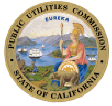 California Public Utilities Commission
California Public Utilities Commission
505 Van Ness Ave., San Francisco
________________________________________________________________________
FOR IMMEDIATE RELEASE PRESS RELEASE
Docket #: A.07-12-018
Contact: Terrie Prosper, 415.703.1366, news@cpuc.ca.gov
CPUC APPROVES 747 OVERLAY FOR 818 AREA CODE
SAN FRANCISCO, April 24, 2008 - The California Public Utilities Commission (CPUC) today approved an all-services overlay that will add a new 747 area code to the same geographic region as the existing 818 area code in order to provide additional telephone numbers to meet consumer demand.
The 818 area code was created in 1984 when it was geographically split from the 213 area code. In 1997, the original 818 area code was split creating the 626 area code and the current 818 area code. The current 818 area code covers predominantly the San Fernando Valley area of Los Angeles County.
An area code overlay adds a second area code to the same geographic region as an existing area code. Therefore, multiple area codes can co-exist within the same geographic region. The CPUC approved an overlay of the 310 area code in 2006, which was successfully implemented.
Customers will not be required to change their existing telephone numbers. New telephone numbers with the 747 area code will be issued to customers requesting new telecommunication services beginning 13 months from today. Consumers may begin using this new dialing procedure (area code plus phone number) six months from today but their calls will still go through if they do not. However, consumers must use the new dialing procedure beginning one year from today.
In approving the overlay, the CPUC granted the request of the North American Numbering Plan Administrator (NANPA) that the CPUC approve an all-services overlay. NANPA holds overall responsibility for the neutral administration of telephone numbers in California, and had determined that the 818 area code is running out of whole prefixes (the first three digits after the area code). The coexistence of both the 818 and 747 area codes will provide additional numbers to the dwindling supply and will allow communications providers to meet the demand for telephone numbers.
The CPUC had previously adopted number conservation measures that extended the life of the 818 area code. But despite these measures, NANPA projects the 818 area code will run out of numbers for consumers in the third quarter of 2009.
"I philosophically support overlays as the correct solution to telephone number shortages in California based on the factual records that have been developed," said Commissioner Timothy Alan Simon. "An overlay also results in the least amount of costs being allocated to consumers and businesses in the affected areas."
To help educate consumers about the new area code, the CPUC established a public education program task force consisting of CPUC staff and at least one representative from each service provider holding numbering resources in the 818 area code.
Prior to approving the area code overlay, the CPUC held public meetings in Burbank, Calabasas, San Fernando, and Van Nuys. Officials in all affected local jurisdictions were notified of the meeting schedule, provided an information package, and invited to participate in a special meeting for local government officials. At all of the meetings, attendees were given the option of indicating their preferences by commenting orally or in writing using comment forms. In addition, the CPUC received input via e-mail and through the CPUC's website. Overall, the CPUC received 741 statements of preferences and comments, of which 442 supported the overlay, 199 favored a geographic split, and 100 did not indicate a preference.
The proposal voted on by the CPUC is at:
http://docs.cpuc.ca.gov/PUBLISHED/AGENDA_DECISION/81599.htm.
For more information on the CPUC, please visit www.cpuc.ca.gov.
###
